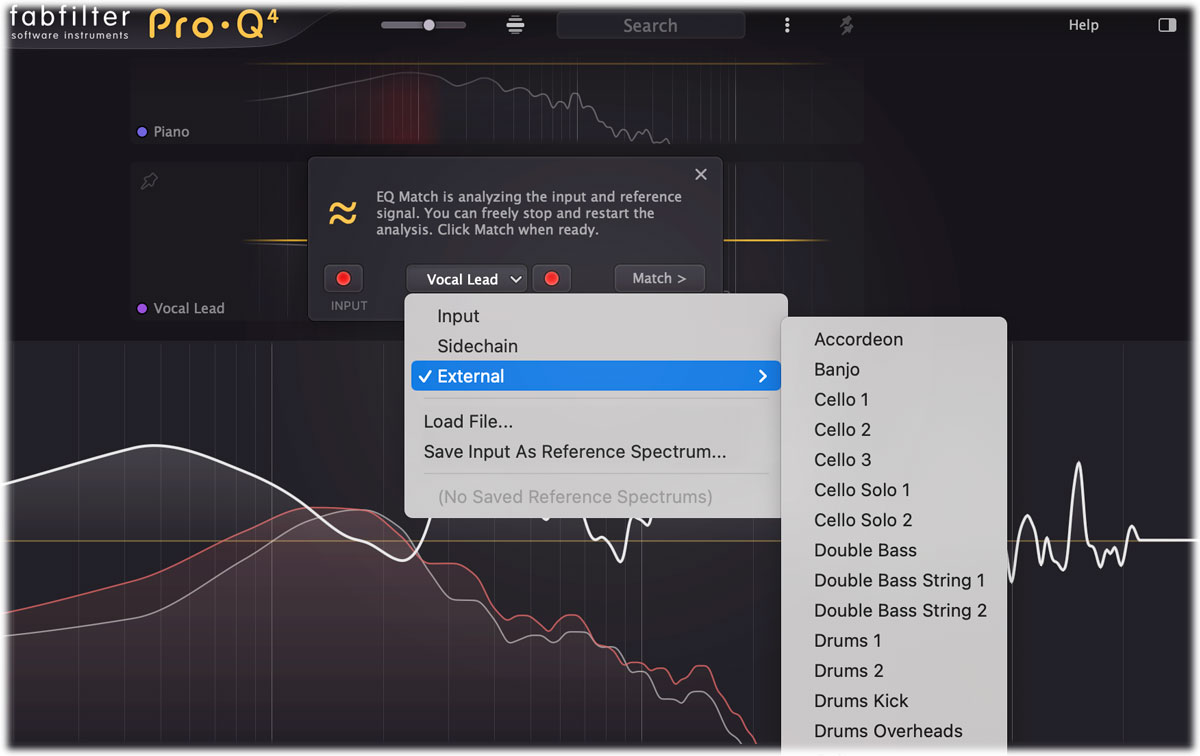FabFilter Pro-Q 4 online help
Table of contents
Go to sectionFabFilter Pro-Q 4 Help
Introduction
Using FabFilter Pro-Q 4
Full Screen mode, resizing and scaling
Presets
Purchasing FabFilter Pro-Q 4
Support
EQ Match
Sometimes, it can be very useful to be able to match the tonal characteristics of a certain reference audio signal. For example, you're in the process of recording vocals, and for some reason you just don't get them to sound like the recordings you made a few days earlier. Or you really like the overall color and sound of a certain mastered song, and want your own track to sound alike.
You can of course add EQ bands and try to find appropriate settings yourself, but Pro-Q offers an automated process to do this for you: EQ Match! It's a simple process that lets you choose or record a reference spectrum, compares it to the spectrum of the current input, and adds new EQ bands to make your audio sound like the reference signal. It gets you 'that' sound in less than a minute.

As the EQ Match process often involves comparing audio of different Pro-Q instances, it is available via the Instance list. Just hover above an instance item, click the menu button that appears at the center right, and choose EQ Match. Then, follow these steps:
Step 1: Choose your reference
Starting EQ Match will open the EQ Match panel above the instance item. By default, EQ Match is already listening to plug-in input and starts analysis right away, building an input spectrum.

Click the Reference button to choose a reference source. You have the following options:
-
Select a previously stored Reference Spectrum
Just choose one of your earlier saved reference spectrums and you're ready to match!To save a spectrum, just add a FabFilter Pro-Q 4 instance to a track that contains the reference audio, open the EQ Match panel, analyze the input for a while and then choose Save Input As Reference Spectrum via the Reference button. Once saved, you can select it as a reference immediately in any other Pro-Q 4 instance.
- Record a reference spectrum via the main plug-in input
Let's say you punched in some new vocals on a track you've recorded a few days ago, and they sound slightly different. In this case, after building the current input spectrum, you can select Input as reference, move the playhead to an earlier point in your song that plays the previously recorded vocal, and build a reference spectrum from it. If needed, you can easily switch back and forth to building the original and reference spectrums, toggling the Record/Pause buttons. - Use an external spectrum as the reference
The External submenu lists all other Pro-Q 4 instances: just click one to use output as the reference to record. Or click Side Chain to use the plug-in's side chain input. The plug-in will then analyze both original and reference spectrums at the same time. Once it has gathered enough information, the Match button will become enabled and you're ready to proceed. If you have pinned another track in the instance list, it will be auto-selected as the external reference here. - Record a reference spectrum from an audio file
Simply click Load File... to open any audio file that will be used to record the spectrum. You can also select a saved reference spectrum file here.
When you're analyzing input or reference audio, the spectrum averages over time, so after a while (normally this doesn't take more than 30 seconds), you'll notice that the detected average spectrum isn't changing much any more. Once a valid input and reference spectum have been analyzed or selected, you'll see a thick white line that shows the difference and the Match button will automatically become available.
Note: If there's no audio detected at the inputs you've chosen to analyze, either because your DAW isn't running or the side chain isn't connected properly, you will be notified about this.
Step 2: Match
After analyzing and clicking the Match button, Pro-Q automatically calculates how many and what kind of EQ bands are needed to match the sound of the side-chain audio. EQ Match now proposes a number of new bands, and gives you the opportunity to customize the matching detail, using the slider.

By choosing more bands, even the smallest differences in the analyzed spectrums will be matched, while choosing less bands will only cover the main shape of the difference spectrum. Usually, there's no need to alter this, as EQ Match intelligently chooses the number of bands that is sufficient to match the most important characteristics of the difference spectrum.
If you're happy with the results, simply click the Finish button (or click anywhere outside the EQ Match panel), after which the new EQ bands are permanently added. Of course, you can also choose to return to the previous step, by clicking the Analyze button.
Notes
- You might see a warning that no audio is being detected for the input and/or reference, so there's nothing to analyze. This usually happens because either your DAW isn't running or because the main plug-in input or the side chain input isn't properly connected and receiving audio.
- The Match button will automatically become available when both a valid input and reference spectrum have been analyzed or selected. Until that time, there's not enough information to match and it will remain disabled.
- EQ Match uses the same resolution as the regular spectrum analyzer. If you need more low-frequency resolution, try setting the Resolution parameter in the analyzer settings to High or Maximum.
- You can also drag and drop audio files onto the EQ Match panel, or even on an instance in the list, to use the file as a reference signal.
Next: Spectrum Grab
See Also
Overview
External side-chaining
Spectrum analyzer
Display and workflow
